NSMB Optimal Filter¶
### Multi-template OF Fit with One Time Shift Degree of Freedom Between Templates¶
Bill Page
Date: 190205
This fit is called the “NSMB Optimal Filter” because it fits amplitudes for:
N signal templates that are allowed to time shift anywhere in the trace
M background templates that are fixed in time.
It was first written by Matt Pyle to subtract off effects of muons from test facility data. It has been resurrected for a different application: fitting background pileup events in the presence of laser-triggered events with known start times. This new application has required some tweaks to the fit. This notebook describes the general algorithm and the things I’ve added to it.
import numpy as np
import qetpy as qp
import matplotlib.pyplot as plt
from helpers import create_example_pulseplusmuontail, create_example_ttl_leakage_pulses
Before getting into how this fit is performed, we motivate it with a few use cases:
1) Fitting out contamination from muons in surface test facility data:¶
At a test facility this fit will help remove pulses from background particles and long thermal muon tails from the data. In the example below we simulate example data with a pulse randomly spaced in time as well as a muon tail (a long fall time exponential feature across the trace).
Then we perform the NSMB fit where the free parameters in the are: * the amplitude of the pulse * the time delay of the pulse * the amplitude of the DC component * the amplitude of the muon tail (slope) component
# create noise + fake pulse + muon tail, also outputting template for pulse and psd for noise
signal, template, psd = create_example_pulseplusmuontail()
signal = (-1)*signal # flip polarity for positive going pulse
plt.figure(figsize=(14,5));
plt.subplot(1,2,1)
plt.plot(signal, '-');
plt.xlabel('bins')
plt.ylabel('Energy (arb)')
plt.title('Example Pulse On Top Of Muon Tail')
plt.grid()
plt.subplot(1,2,2)
plt.plot(signal,'-')
plt.xlim([10000, 18000])
plt.xlabel('bins')
plt.ylabel('Energy (arb)')
plt.title('Zoomed in on the pulse')
plt.grid()
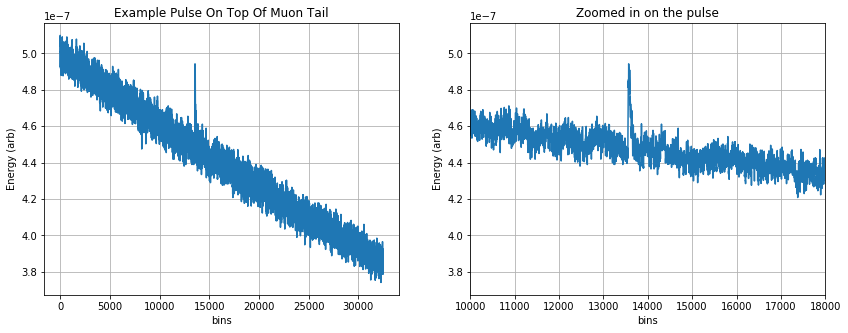
nbin = len(signal)
# construct the background templates which are just a slope and a baseline
backgroundtemplates, backgroundtemplatesshifts = qp.get_slope_dc_template_nsmb(nbin)
# setup the NSMB
fs = 625e3 # example sample rate
(psddnu,phi,Pfs, P, sbtemplatef,
sbtemplatet,iB,B,ns,nb,bitcomb,lfindex) = qp.of_nsmb_setup(template, backgroundtemplates, psd, fs)
# invert the P matrix -- see below if interested in this
iP = qp.of_nsmb_getiP(P)
# give bin window over which to look for signal
indwindow = np.arange(0,len(template))
# put the window into a list (can have multiple list elements)
indwindow_nsmb = [indwindow[:,None].T]
lgcplotnsmb = True
(amps_nsmb, t0_s_nsmb, chi2_nsmb,
chi2_nsmb_lf,resid) = qp.of_nsmb(signal,
phi,
sbtemplatef.T,
sbtemplatet, iP,
psddnu.T, fs,
indwindow_nsmb, ns, nb,
bitcomb, lfindex,
lgcplot=lgcplotnsmb, lgcsaveplots=False)
fig = plt.gcf()
fig.set_size_inches(7,5)
plt.xlim([10000, 18000]);
plt.ylabel('Energy (arb)');
plt.title('NSMB Fit: zoomed in on the pulse');
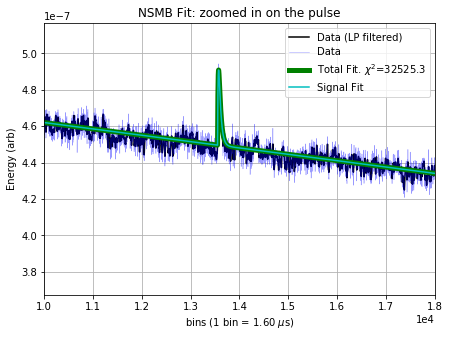
By eye, the 4 free parameters (the amplitude of the pulse, the time delay of the pulse, the amplitude of the DC component, the amplitude of the slope component) have been fit well. One could imagine cutting on the amplitude of the pulse to obtain a better selection of noise, or subtracting the slope fit from the data to remove the contamination from muons, thereby recovering a noise trace that is a closer realization of the fundamental electronic noise.
On to the next use case:
2) Fitting pileup background events in the presence of laser-triggered events with known start times:¶
fs = 625e3
ttlrate = 2e3
# create noise + fake laser trigger pulses at certain start times + a background pulse at a random time
# also outputting template for the pulse shapes and psd for noise
signal, template, psd = create_example_ttl_leakage_pulses(fs,ttlrate)
signal = (-1)*signal # flip polarity for positive going pulse
nbin = len(signal)
# get templates for background, as well as
(backgroundtemplates,
backgroundtemplateshifts,
backgroundpolarityconstraint,
indwindow_nsmb) = qp.maketemplate_ttlfit_nsmb(template,
fs,
ttlrate,
lgcconstrainpolarity=True,
lgcpositivepolarity=True,
notch_window_size=1)
plt.figure(figsize=(14,5));
plt.plot(signal, '-');
plt.xlabel('bins')
plt.ylabel('Energy (arb)')
plt.title('Example periodic train of laser pulses with 1 background pulse at a random time')
plt.grid()
plt.axvline(x=backgroundtemplateshifts[0],linestyle='--', color='m', linewidth=1, label='laser firing times')
for ii in range(1, len(backgroundtemplateshifts)):
plt.axvline(x=backgroundtemplateshifts[ii],linestyle='--', color='m', linewidth=1)
plt.legend();

# concatenate signal and background template matrices and take FFT
sbtemplatef, sbtemplatet = qp.of_nsmb_ffttemplate(np.expand_dims(template,1), backgroundtemplates)
(psddnu, phi, Pfs, P,
sbtemplatef, sbtemplatet, iB,
B, ns, nb, bitcomb, lfindex) = qp.of_nsmb_setup(template, backgroundtemplates, psd, fs)
sigpolarityconstraint = np.ones(1)
lgcplotnsmb = True
(amps_nsmb,t0_s_nsmb,
chi2_nsmb,chi2_nsmb_lf,
resid,amps_sig_nsmb_cwindow,
chi2_nsmb_cwindow,
t0_s_nsmb_cwindow,
amp_s_nsmb_int,
t0_s_nsmb_int,
chi2_nsmb_int,
amps_sig_nsmb_cwindow_int,
chi2_nsmb_cwindow_int,
t0_s_nsmb_cwindow_int) = qp.of_nsmb_con(signal, phi, Pfs,
P, sbtemplatef.T, sbtemplatet,
psddnu.T, fs, indwindow_nsmb, ns,nb, bitcomb, lfindex,
background_templates_shifts=backgroundtemplateshifts,
bkgpolarityconstraint=backgroundpolarityconstraint,
sigpolarityconstraint=sigpolarityconstraint,
lgcplot=lgcplotnsmb, lgcsaveplots=False)
fig = plt.gcf()
fig.set_size_inches(14,5)
plt.ylabel('Energy (arb)');
plt.title('NSMB Fit');
all good
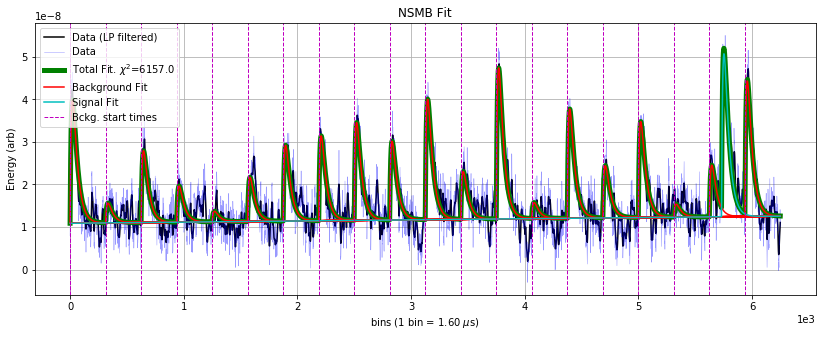
There is a large background pileup pulse at bin ~ 5700, which is fit as the signal component because it occurs outside of the known times that the laser fires at the detector (given by the vertical lines). One might want to construct a discrimination parameter to determine, in a statistical sense, the likelihood that a background pileup pulse exists in the data.
To do this, we rerun the fit without the signal component and look at the \(\Delta \chi^2\) between the two fits:
(ampsbonly_nsmb, chi2bonly_nsmb,
chi2bonly_nsmb_lf) = qp.of_mb(signal, phi, sbtemplatef.T, sbtemplatet,
iB, B, psddnu.T, fs, ns, nb, lfindex,
background_templates_shifts=backgroundtemplateshifts,
bkgpolarityconstraint=backgroundpolarityconstraint,
sigpolarityconstraint=sigpolarityconstraint,
lgcplot=True, lgcsaveplots=False)
fig = plt.gcf()
fig.set_size_inches(14, 5)
plt.ylabel('Energy (arb)');
plt.title('Background Only Fit');
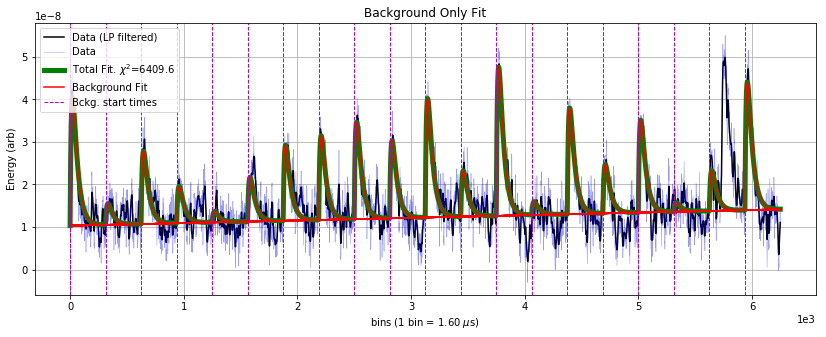
The difference in \(\chi^2\) between the fits is 6409.6 - 6157 = 252.6. For noise to produce this \(\Delta \chi^2\), it would be a \(\sigma = \sqrt{\Delta \chi^2} \sim 16\) fluctuation — so we can say with high confidnce there’s background pileup here.
Derivation¶
The \(\chi^2\) for the fit is
where we have defined
\(t_{0}\): the time offset of the N signal templates
\(J\): the noise PSD
\(S\): the trace
\(A\): the templates
\(N/M\): the number of signal/background templates
\(n/m\): the index over signal/background templates
\(k\): the index over frequencies
We analytically solve for the \(\chi^2\) minimum and speed up the calculation by using the inverse Fourier transform wherever possible.
Below we derive the solution for 1 signal template and 2 background templates (\(N\)=1, \(M\)=2), though the algorithm is written for arbitrary values of N and M. The \(\chi^2\) for this specific case is given by:
Minimizing the \(\chi^2\) with respect to the three amplitudes, by solving \(\frac{\partial{\chi^2}}{\partial{a_1}} = \frac{\partial{\chi^2}}{\partial{a_2}} = \frac{\partial{\chi^2}}{\partial{a_3}} = 0\), gives the following equation for the best fit amplitudes, \(\bf{a}\):
- :raw-latex:`begin{equation}
textbf{a}= textbf{P}^{-1} cdot textbf{q} tag{1}
end{equation}`
where the \(\textbf{P}\) matrix is
- :raw-latex:`begin{equation}
textbf{P} = left( begin{array}{ccc}
sum_{k}frac{tilde{A}_{1,k}^{*}tilde{A}_{1,k}}{J_{k}} & sum_{k}frac{tilde{A}_{1,k}^{*}tilde{A}_{2,k}e^{2pi i t_0 f_k}}{J_{k}} & sum_{k}frac{tilde{A}_{1,k}^{*}tilde{A}_{3,k}e^{2pi i t_0 f_k}}{J_{k}} \ sum_{k}frac{tilde{A}_{1,k}^{*}tilde{A}_{2,k}e^{2pi i t_0 f_k}}{J_{k}} & sum_{k}frac{tilde{A}_{2,k}^{*}tilde{A}_{2,k}}{J_{k}} & sum_{k}frac{tilde{A}_{2,k}^{*}tilde{A}_{3,k}}{J_{k}} \ sum_{k}frac{tilde{A}_{1,k}^{*}tilde{A}_{3,k}e^{2pi i t_0 f_k}}{J_{k}} & sum_{k}frac{tilde{A}_{2,k}^{*}tilde{A}_{3,k}}{J_{k}} & sum_{k}frac{tilde{A}_{3,k}^{*}tilde{A}_{3,k}}{J_{k}} \ end{array} right) end{equation}`
and the \(\textbf{q}\) vector is
- :raw-latex:`begin{equation}
textbf{q} = left( begin{array}{ccc}
sum_{k}frac{tilde{S}_{k}tilde{A}_{1,k}^{*}e^{2pi i t_0 f_k}}{J_{k}} \ sum_{k}frac{tilde{S}_{k}tilde{A}_{2,k}^{*}}{J_{k}} \ sum_{k}frac{tilde{S}_{k}tilde{A}_{3,k}^{*}}{J_{k}} \ end{array} right) end{equation}`
Equation 1 hides some of the complexity of the calculation because both \(\textbf{P}\) and \(\textbf{q}\) depend on \(t_0\), the time delay offset of the signal template. In the algorithm, the amplitudes are calculated for each time delay–\(\textbf{a}(t_0)\)–and for the global minimum we pick the time delay that gives the lowest \(\chi^2\). This initially seems to be getting nasty computationally, where if your data has 4096 time bins you have to do 4096 matrix inversions, but we can speed up the calculation in a couple ways:
The \(\textbf{P}\) matrix does not depend on the data \(S\) and therefore it can be precomputed and inverted for every \(t_0\) before looping over the traces
We will see below that to impose amplitude polarity constraints, we will not be able to precompute \(\textbf{P}\) as it would require too much RAM, and so the algorithm is much slower if amplitude polarity constraints are turned on
The first row of \(\textbf{q}\) and the first row and column of \(\textbf{P}\), except for the (1,1) element, are inverse Fourier transforms. Using the same old trick that is used in the stanard optimal filter algorithm with a time delay, these elements can be computed quickly in \(\mathcal{O}(n \text{log} n)\) time.
Polarity Constraint¶
The location in the parameter space where there is an absolute miniumum of the \(\chi^2\), given by Equation 1, can be non-physical. What is an example of a non-physical best fit result? Here you go:
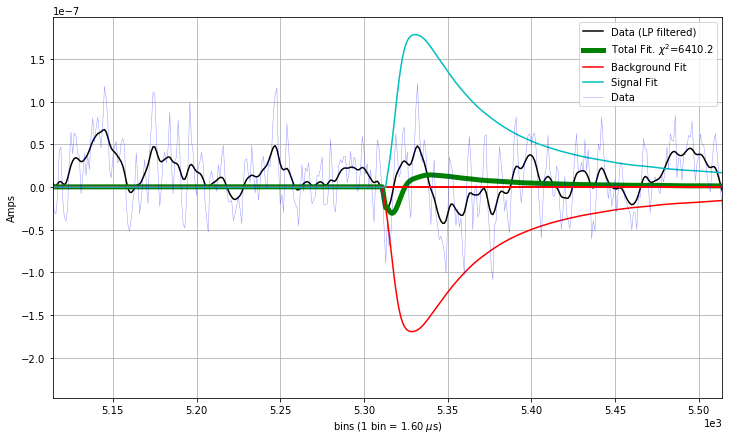
What is going on above? * If there is not a background pileup pulse, the minimum of the \(\chi^2\) can have the signal template interfere with the background template in order to fit noise.
To fix this, we can impose physical constraints on the amplitude values in the fit, by which we mean that if the detector has been biased so that pulses go in the positive direction, we disallow negative fit amplitudes.
The procedure for imposing an amplitude polarity constraint is more involved for this multi-dimensional amplitude space than for the simple 1D optimal filter. For the problematic fit above, for constraining the amplitudes to be positive, what is a robust but fast way to find the minimum in the allowed region (the region with no negative amplitudes)?
A flawed procedure would be to constrain the negative background amplitude to 0
It could very well be that then, on the second minimization, the signal amplitude would be fit negative
Do you then set the signal amplitude to 0 as well?
Sequential approaches are a bad idea when doing highly correlated fits!
A robust and fast procedure is to use the gradient to determine which amplitudes to constrain to 0
The below plot shows the \(\chi^2\) gradient, determined with the covariance matrix between signal and background amplitudes, for the fit above, with the absolute minimum in red:
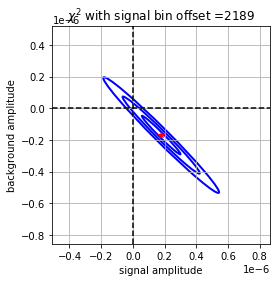
We can calculate the gradient at different points in the parameter space quickly because the covariance matrix (\(\textbf{E}\)) and the Hessian(\(\textbf{H}\)) comes for free from unconstrained calculation, from their relation to the P matrix:
This correspondence might be more familiar by remembering that the standard 1D optimal filter amplitude estimate variance is
The gradient anywhere in the parameter space can be done with the Hessian, where \(\textbf{H} = \frac{1}{2}\textbf{E}^{-1} = \frac{1}{2}\textbf{P}\) and
The gradient at a point \(\textbf{a}\) in the parameter sapce is just given by
In practice, here is how we use gradient information:
we find the abolute minimum. if some amplitudes are in a disallowed region of the space we:
we check the gradient at the closest point in the allowed parameter space
for those amplitudes in the disallowed region:
if the gradient points into the disallowed region then those amplitudes are set to zero
if the gradient points into the allowed region then those amplitudes are not set to zero (allowed to float)
we refit with the certain amplitudes taken out of the fit
we redo this process until, for all the amplitudes that are set to zero, the gradient points into the disallowed region
if this check fails then we output a warning flag in the fit
have never seen this failure
typically this only takes one iteration! much faster than a gradient descent!
In the algorithm a few quantities are precomputed to speed up calculations. In the code, these quantities are named and defined as below:
\(\textbf{PF}\), a 3 by 3 by k matrix
- :raw-latex:`begin{equation}
textbf{PF} = left( begin{array}{ccc}
frac{tilde{A}_{1,k}^{*}tilde{A}_{1,k}}{J_{k}} & frac{tilde{A}_{1,k}^{*}tilde{A}_{2,k}}{J_{k}} & frac{tilde{A}_{1,k}^{*}tilde{A}_{3,k}}{J_{k}} \ frac{tilde{A}_{1,k}^{*}tilde{A}_{2,k}}{J_{k}} & frac{tilde{A}_{2,k}^{*}tilde{A}_{2,k}}{J_{k}} & frac{tilde{A}_{2,k}^{*}tilde{A}_{3,k}}{J_{k}} \ frac{tilde{A}_{1,k}^{*}tilde{A}_{3,k}}{J_{k}} & frac{tilde{A}_{2,k}^{*}tilde{A}_{3,k}}{J_{k}} & frac{tilde{A}_{3,k}^{*}tilde{A}_{3,k}}{J_{k}} \ end{array} right) end{equation}`
\(\textbf{PFS}\), a 3 by 3 matrix
- :raw-latex:`begin{equation}
textbf{PFS} = left( begin{array}{ccc}
sum_{k}frac{tilde{A}_{1,k}^{*}tilde{A}_{1,k}}{J_{k}} & sum_{k}frac{tilde{A}_{1,k}^{*}tilde{A}_{2,k}}{J_{k}} & sum_{k}frac{tilde{A}_{1,k}^{*}tilde{A}_{3,k}}{J_{k}} \ sum_{k}frac{tilde{A}_{1,k}^{*}tilde{A}_{2,k}}{J_{k}} & sum_{k}frac{tilde{A}_{2,k}^{*}tilde{A}_{2,k}}{J_{k}} & sum_{k}frac{tilde{A}_{2,k}^{*}tilde{A}_{3,k}}{J_{k}} \ sum_{k}frac{tilde{A}_{1,k}^{*}tilde{A}_{3,k}}{J_{k}} & sum_{k}frac{tilde{A}_{2,k}^{*}tilde{A}_{3,k}}{J_{k}} & sum_{k}frac{tilde{A}_{3,k}^{*}tilde{A}_{3,k}}{J_{k}} \ end{array} right) end{equation}`
\(\phi\), a 3 by k matrix
- :raw-latex:`begin{equation}
phi = left( begin{array}{ccc}
frac{tilde{A}_{1,k}^{*}}{J_{k}} \ frac{tilde{A}_{2,k}^{*}}{J_{k}} \ frac{tilde{A}_{3,k}^{*}}{J_{k}} \ end{array} right) end{equation}`